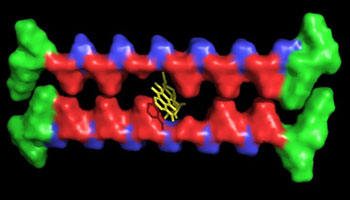Custom Designed Peptides Transport Hydrophobic Drug Compounds
By LabMedica International staff writers
Posted on 20 Jun 2016
A bioengineering team has designed a novel class of drug-delivery peptides that coalesce into a hydrogel capable of transporting hydrophobic compounds within the hydrophobic cores of the peptide nanofibers.Posted on 20 Jun 2016
Multidomain peptides (MDPs) provide biocompatible hydrogel scaffolds that are injectable and space-conforming, allowing for in situ delivery of a variety of drugs. Investigators at Rice University (Houston, TX, USA) demonstrated that through manipulation of the peptide primary sequence, a molecular cavity (missing tooth) could be incorporated into the hydrophobic core of these peptide nanofibers allowing for encapsulation and delivery of small molecule drugs with poor water solubility.

Image: Molecular model of a hydrogel consisting of custom peptide fibers with spaces - \"missing teeth\" - that can trap and deliver hydrophobic small-molecule drugs (Photo courtesy of I-Che Li, Rice University).
The investigators reported in the June 2, 2016, online edition of the journal Biomacromolecules that the drugs SN-38, daunorubicin, diflunisal, etodolac, levofloxacin, and norfloxacin could be encapsulated and released from multidomain peptide fibers. Steady-state fluorescence and drug release studies showed that hydrogels loaded with SN-38, diflunisal, and etodolac exhibited prolonged drug release profiles due to intrafibrillar drug encapsulation.
"Here, we have done something different - we modify the inside of the fibers," said senior author Dr. Jeffery Hartgerink, professor of chemistry and bioengineering at Rice University. "We remove part of the internal portion of the fiber – that is the missing tooth - and that is a hydrophobic environment. Hydrophilic molecules frequently do not need a delivery mechanism because you can inject them. They are water-soluble, they go into the blood and they are fine. But hydrophobic drugs are challenging to deliver. We load them into the interstices of these fibers, and they can be delivered wherever we inject the hydrogel."
Related Links:
Rice University













